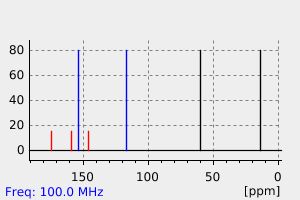3-甲氧基-2-甲基-4H-吡喃-4-酮 | 4780-14-7
中文名称
3-甲氧基-2-甲基-4H-吡喃-4-酮
中文别名
2-甲基-3-甲氧基-4H-吡喃-4-酮
英文名称
3-methoxy-2-methyl-4-pyrone
英文别名
3-methoxy-2-methyl-4H-pyran-4-one;methyl maltol;2-methyl-3-methoxypyran-4-one;3-methoxy-2-methyl-pyran-4-one;3-methoxy-2-methylpyran-4-one
CAS
4780-14-7
化学式
C7H8O3
mdl
MFCD14553191
分子量
140.139
InChiKey
NGGPLHHTRNJSDT-UHFFFAOYSA-N
BEILSTEIN
——
EINECS
——
-
物化性质
-
计算性质
-
ADMET
-
安全信息
-
SDS
-
制备方法与用途
-
上下游信息
-
文献信息
-
表征谱图
-
同类化合物
-
相关功能分类
-
相关结构分类
计算性质
-
辛醇/水分配系数(LogP):0.7
-
重原子数:10
-
可旋转键数:1
-
环数:1.0
-
sp3杂化的碳原子比例:0.285
-
拓扑面积:35.5
-
氢给体数:0
-
氢受体数:3
安全信息
-
储存条件:应存于室温、密闭且干燥的环境中。
上下游信息
-
上游原料
中文名称 英文名称 CAS号 化学式 分子量 麦芽醇 Maltol 118-71-8 C6H6O3 126.112 3-(苄氧基)-2-甲基-4H-吡喃-4-酮 3-O-benzylmaltol 61049-69-2 C13H12O3 216.236 -
下游产品
中文名称 英文名称 CAS号 化学式 分子量 2-(羟甲基)-3-甲氧基-4H-吡喃-4-酮 2-(hydroxymethyl)-3-methoxy-4H-pyran-4-one 106203-46-7 C7H8O4 156.138 —— 2-(bromomethyl)-3-methoxy-4H-pyran-4-one 2860-26-6 C7H7BrO3 219.035 3-甲氧基-4H-吡喃-4-酮-2-甲醛 3-methoxy-4H-pyran-4-one-2-carboxaldehyde 106203-47-8 C7H6O4 154.122 —— 3-Methoxy-2-(4-methyl-pent-3-enyl)-pyran-4-one 147685-87-8 C12H16O3 208.257 —— 2-(1-hydroxypropyl)-3-methoxy-4H-pyran-4-one 1436415-50-7 C9H12O4 184.192
反应信息
-
作为反应物:描述:3-甲氧基-2-甲基-4H-吡喃-4-酮 在 ammonium hydroxide 、 sodium hydroxide 、 氯化亚砜 、 sodium methylate 、 间氯过氧苯甲酸 、 三氯氧磷 作用下, 以 二氯甲烷 为溶剂, 反应 34.0h, 生成 2-氯甲基-3,4-二甲氧基吡啶盐酸盐参考文献:名称:Structure-Activity Relationship of Omeprazole and Analogs as Helicobacter pylori Urease Inhibitors摘要:Helicobacter pylori urease belongs to a family of highly conserved urea-hydrolyzing enzymes. A common feature of these enzymes is the presence of two Lewis acid nickel ions and a reactive cysteine residue in the active site. The H+/K(+)-ATPase inhibitor omeprazole is a prodrug of a sulfenamide which covalently modifies cysteine residues on the luminal side of the H+/K(+)-ATPase of gastric parietal cells. Omeprazole and eight analogues were selected based on their chemical, electronic, and kinetic properties, and each was incubated with viable H. pylori in phosphate-buffered saline at pH 7.4 for 30 min, after which 100 mM urea was added and the amount of ammonia formed analyzed after a further 10 min. Inhibition between 0% and 100% at a 0.1 mM concentration was observed for the different analogues and could be expressed as a function of the pKa-value of the pyridine, the pKa-value of the benzimidazole, the overall lipophilicity, and, most importantly, the rate of sulfenamide formation, in a quantitative structure-activity relationship. The inhibition was potentiated by a lower pH (favoring the formation of the sulfenamide) but abolished in the presence of beta-mercaptoethanol (a scavenger of the sulfenamide). Structural analogues incapable of yielding the sulfenamide did not inhibit ammonia production. Treatment of Helicobacter felis-infected mice with 230 mumol/kg flurofamide b.i.d. for 4 weeks, known to potently inhibit urease activity in vivo, as a means of eradicating the infection, was tested and compared with the effect of 125 mumol/kg omeprazole b.i.d. for 4 weeks. Neither treatment proved efficacious.DOI:10.1021/jm00025a008
-
作为产物:描述:参考文献:名称:HETEROCYCLIC COMPOUND摘要:本发明提供了一种具有葡糖鞘氨醇合成酶抑制作用的化合物,预计可用作预防或治疗溶酶体贮存病(如高氏病、法布里病、GM1-神经节苷脂沉积症、GM2活化剂缺乏症、泰-萨克斯病、桑德霍夫病)、神经退行性疾病(如帕金森病、Lewy体痴呆、多系统萎缩症)等的药物。本发明涉及一种由式(I)表示的化合物,其中每个符号如说明书所述,或其盐。公开号:US20220274982A1
文献信息
-
Identification of N-phenyl-3-methoxy-4-pyridinones as orally bioavailable H3 receptor antagonists and β-amyloid aggregation inhibitors for the treatment of Alzheimer’s disease作者:Minkui Zhang、Li Tang、Liu Jiang、Jun Wei、Yongzhou Hu、Rong ShengDOI:10.1016/j.ejmech.2020.113096日期:2021.2functional agents for therapy of Alzheimer’s disease, through introducing alkyloxy moiety into 4-pyridinone ring to avoid the possible phase II metabolism of 3-hydroxy-4-pyridinone in lead compound 3-hydroxy-2-methyl-1-(4-(3-(pyrrolidin-1-yl)propoxy)phenyl)-pyridin-4(1H)-one (4). In vitro studies indicated that most of these compounds exhibit excellent H3 receptor antagonistic activities and potent根据我们以前的工作,通过将烷氧基部分引入4-吡啶酮环中以避免可能的II期,设计了一系列N-苯基-3-甲氧基-4-吡啶酮衍生物作为口服生物可利用的双重功能药物,用于治疗阿尔茨海默氏病铅化合物的3-羟基-4-吡啶酮的代谢3-羟基-2-甲基-1-(4-(3-(吡咯烷-1-基)丙氧基)苯基) -吡啶-4-(1 ħ) -酮( 4)。体外研究表明,这些化合物大多数都具有出色的H 3受体拮抗活性和强力的自诱导Aβ1-40 / Aβ1-42聚集抑制活性。特别是,3-甲氧基-1-(4-(3-(吡咯烷基-1-基)丙氧基)苯基)-吡啶-4(1H)-一(7i)在H 3 R拮抗作用中显示IC 50值为0.52 nM。对其他组胺受体亚型具有良好的选择性。透射电子显微镜(TEM)图像显示化合物7i可有效抑制自我介导的Aβ1-40 / Aβ1-42聚集。如预期的那样,它在血浆中表现出理想的药代动力学性质和良好的BBB渗透
-
N-取代苯基吡啶-4-酮衍生物及其制备和应用申请人:浙江大学公开号:CN103588702B公开(公告)日:2016-01-06本发明提供N-取代苯基吡啶-4-酮衍生物及其盐,通过邻羟基吡喃酮衍生物与氨基苯酚缩合,然后经烷基化、胺缩合、氢化脱保护等步骤合成目标物。本发明设计合成一系列N-取代苯基吡啶-4-酮衍生物,药理活性筛选试验表明该类化合物具有显著的组胺H3受体拮抗活性和抗Aβ聚集活性。本发明提供的N-取代苯基吡啶-4-酮衍生物及其盐以及制备中的中间体可在制备早老性痴呆相关药物中的应用,尤其是作为组胺H3受体拮抗剂和淀粉样蛋白肽(Aβ)聚集抑制剂,在制备治疗与组胺H3受体和Aβ聚集有关的疾病的药物中的用途。本发明化合物的合成所需原料易得,路线设计合理,反应条件温和,各步收率高,操作简便,生产成本较低。结构通式如下。
-
Prediction of 3-hydroxypyridin-4-one (HPO) hydroxyl pKa values作者:Yu-Lin Chen、Dave J. Barlow、Xiao-Le Kong、Yong-Min Ma、Robert C. HiderDOI:10.1039/c2dt12396g日期:——As an aid in optimising the design of 3-hydroxypyridin-4-ones (HPOs) intended for use as therapeutic Fe3+ chelating agents, various quantum mechanical (QM) and semi-empirical (QSAR) methods have been explored for predicting the pKa values of the hydroxyl groups in these compounds. Using a training set of 15 HPOs with known hydroxyl pKa values, reliable predictions are shown to be obtained with QM calculations using the B3LYP/6-31+G(d)/CPCM model chemistry (with Pauling radii, and water as solvent). With this methodology, the observed hydroxyl pKa values for the training set compound are closely matched by the predicted pKa values, with the correlation between the observed and predicted values giving r2 = 0.98. Predictions subsequently made by this method for a test set of 48 HPOs of known hydroxyl pKa values (11 of which were determined experimentally in this study), gave predicted pKa values accurate to within ±0.2 log units. In order to further investigate the predictive power of the method, two novel HPOs were synthesised and their hydroxyl pKa values were determined experimentally. Comparison of these predicted pKa values against the measured values gave absolute deviations of 0.13 (10.18 vs. 10.31) and 0.43 (5.58 vs. 5.15).作为优化用于治疗性Fe3+螯合剂的3-羟基吡啶-4-酮(HPOs)设计的辅助工具,探索了多种量子力学(QM)和半经验(QSAR)方法,用于预测这些化合物中羟基的pKa值。利用15个已知羟基pKa值的HPO训练集,结果表明,使用B3LYP/6-31+G(d)/CPCM模型化学(采用Pauling半径,并以水作为溶剂)所进行的QM计算可以获得可靠的预测。采用这种方法,训练集中化合物的观察到的羟基pKa值与预测的pKa值紧密匹配,观察值与预测值之间的关联性为r² = 0.98。随后,该方法对48个已知羟基pKa值的HPO测试集(其中11个是在本研究中实验确定的)进行了预测,预测的pKa值在±0.2对数单位内是准确的。为了进一步研究该方法的预测能力,合成了两个新型HPO,并实验确定了它们的羟基pKa值。将这些预测的pKa值与测量值进行比较,得到了绝对偏差分别为0.13(10.18 vs. 10.31)和0.43(5.58 vs. 5.15)。
-
具有铁螯合和单胺氧化酶B抑制活性的香豆 素杂合吡啶酮类化合物及其制备与应用申请人:浙江工业大学公开号:CN110218207B公开(公告)日:2020-12-25
-
具潜在抗AD活性的香豆素杂合吡啶酮酰胺衍 生物及其制备方法与应用
表征谱图
-
氢谱1HNMR
-
质谱MS
-
碳谱13CNMR
-
红外IR
-
拉曼Raman
-
峰位数据
-
峰位匹配
-
表征信息
同类化合物
(2R)-2,6-二羟基-5-[(E)-丙-1-烯基]-1,2-二氢吡喃并[3,2-b]吡咯-3,7-二酮
黄绿青霉素
麦芽醇
麦芽酚铁
马索亚内酯
香豆酸
香豆灵酸甲酯
香叶吡喃
顺式-1-(3-呋喃基)-1,7,8,8a-四氢-5,8a-二甲基-3H-2-苯并吡喃-3-酮
靠曼酸乙酯; 4-吡喃酮-2-羧酸乙酯
靠曼酸
镭杂9蛋白质
铝3-羟基-2-甲基-4-吡喃酮
钠[(1E,7E,9E,11E)-6-羟基-1-(3-羟基-6-氧代-2,3-二氢吡喃-2-基)-5-甲基十七碳-1,7,9,11-四烯-4-基]硫酸盐
避虫酮
辛伐他汀杂质C
褐鸡蛋花素
脱氢乙酸缩氨基硫脲
脱氢乙酸
罌粟酸
维达列汀
福司曲星
福司曲星
磷内酯霉素F
磷内酯霉素E
磷内酯霉素D
磷内酯霉素A
白屈菜酸
甲基6-甲氧基-2-甲基-5-氧代四氢-2H-吡喃-2-羧酸酯
甲基6-氧杂双环[3.1.0]己烷-1-羧酸酯
甲基4-氧代-4H-吡喃-3-羧酸酯
甲基4,6-二-O-乙酰基-2,3-二脱氧己-2-烯基吡喃糖苷
甲基2H-吡喃-5-羧酸酯
甲基2-乙氧基-6-甲基-3,4-二氢-2H-吡喃-4-羧酸酯
甲基2-乙氧基-4-氧代-3,4-二氢-2H-吡喃-5-羧酸酯
甲基2-乙氧基-3-甲基-4-氧代-3,4-二氢-2H-吡喃-5-羧酸酯
甲基(4S)-2-氧代-4-[(2E)-1-氧代-2-丁烯-2-基]-3,4-二氢-2H-吡喃-5-羧酸酯
甲基(2S,5R)-5-甲氧基-3-硝基-2,5-二氢-2-呋喃羧酸酯
甲基(2S)-4-甲基-3,6-二氢-2H-吡喃-2-羧酸酯
甲基(2R)-四氢-2H-吡喃-2-羧酸酯
环庚三烯并[b]吡喃-2(5H)-酮,9-(3-丁烯基)-3-(环丙基苯基甲基)-6,7,8,9-四氢-4-羟基-
环吡酮杂质B
焦袂康酸O-甲基醚
沉香四醇
氨甲酸,[3-[(苯基甲基)氨基]三环[3.3.1.13,7]癸-1-基]-,1,1-二甲基乙基酯(9CI)
毛子草酮
棒曲霉素-13C3
棒曲霉素
木菌素
木糖酸二钠盐







